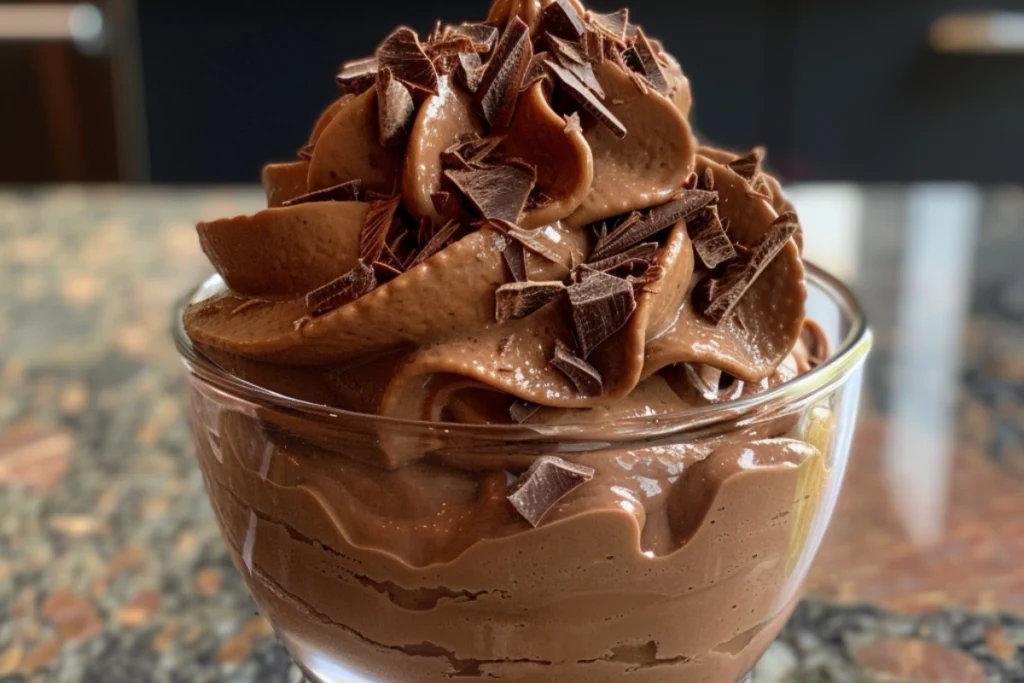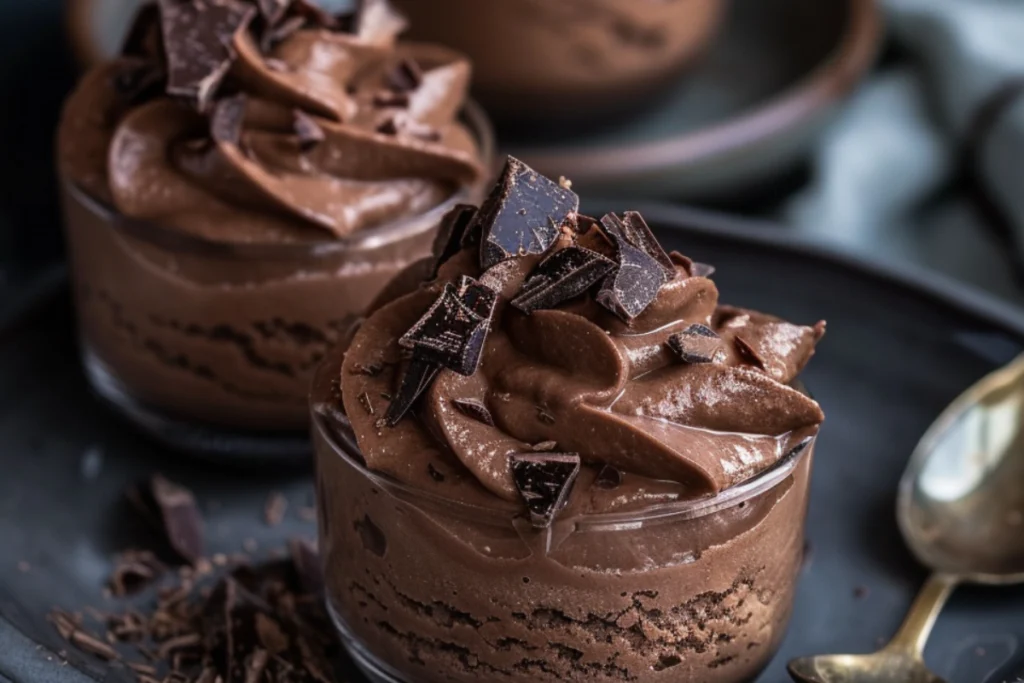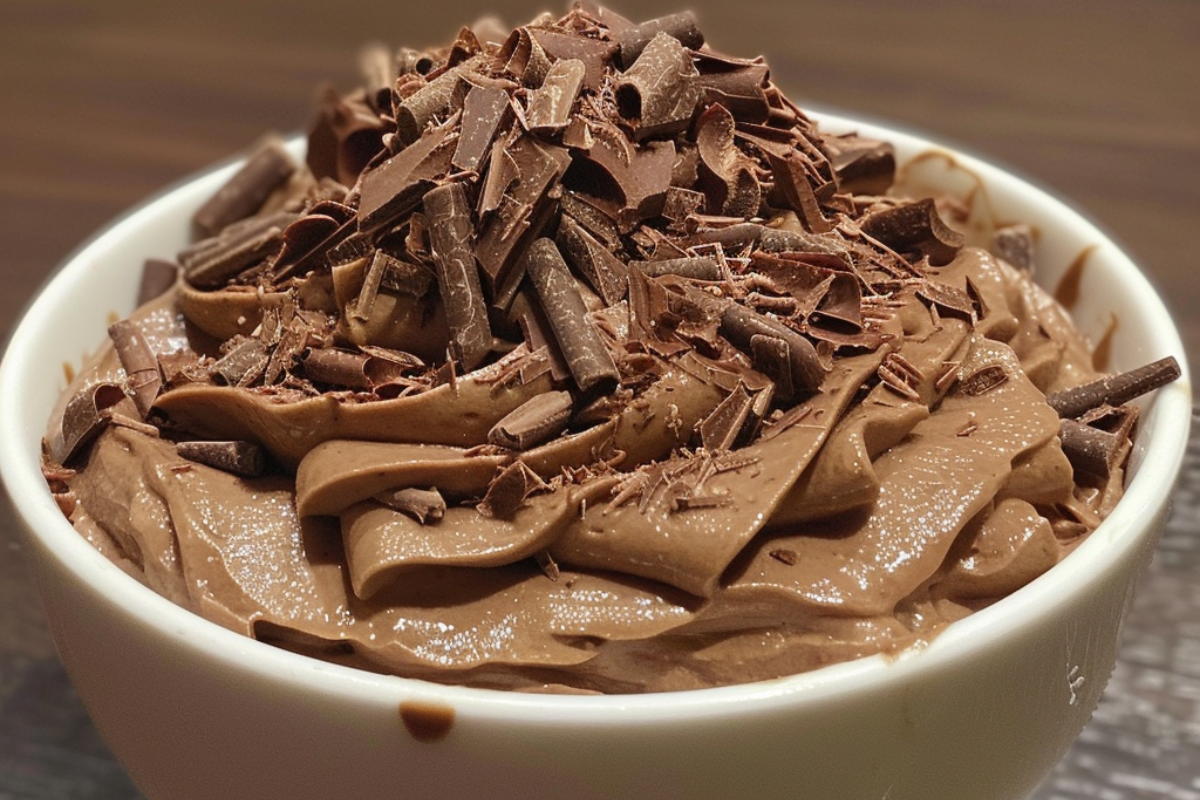Introduction to Chocolate Mousse
Chocolate mousse is a dessert that epitomizes the elegance and decadence of chocolate in its most velvety, airy form. Originating in France, it has become a beloved treat worldwide, revered for its rich flavor and luxurious texture.
Overview of Chocolate Mousse
Chocolate mousse, literally meaning “foam” in French, offers a stunning balance of richness and lightness, making it a favorite among dessert aficionados. This dessert traditionally combines chocolate, sugar, butter, and eggs, each element contributing to the delicate yet intense chocolate experience.
Origin and Historical Significance
The exact origins of chocolate mousse are somewhat murky, but it is believed to have been developed in the early 20th century in France. It gained popularity as chefs experimented with new ways to showcase chocolate, capitalizing on its popularity after it was introduced to Europe. The dessert was embraced for its simplicity and the way it allowed the pure flavor of chocolate to shine through.
The Allure of Chocolate Mousse for Chocolate Lovers
For chocolate lovers, mousse offers a unique sensory experience. Unlike other chocolate desserts that might be dense or overly sweet, chocolate mousse provides a light, almost ethereal quality that allows the chocolate to melt away on the tongue, leaving behind a rich aftertaste that invites another bite. Its versatility also makes it a canvas for innovation, incorporating various flavors and textures that complement the base of smooth chocolate.
This introduction sets the stage for a deeper exploration into the nuances of making chocolate mousse, from the selection of ingredients to the precise techniques needed to achieve the perfect consistency. The following sections will guide you through each step of the process, ensuring that even a novice can master this exquisite dessert.
-Ingredients and Tools for Chocolate Mousse
Achieving a perfect chocolate mousse requires careful selection of ingredients and proper preparation. The quality of each ingredient profoundly impacts the flavor and texture of the final result. Likewise, having the right tools on hand will make the preparation process smooth and enjoyable.
-Key Ingredients
- High-Quality Chocolate
- The star ingredient of any chocolate mousse is chocolate. Aim for high-quality chocolate with at least 60-70% cocoa content. Choose chocolate with a smooth texture and minimal additives, as this will contribute to a richer, more intense flavor. Milk and white chocolate can also be used but will produce a milder mousse.
- Cream
- Heavy cream or whipping cream gives the mousse its light, airy texture. Make sure to use cream with a fat content of at least 35% for optimal whipping.
- Eggs
- Fresh eggs are crucial for a stable mousse. Egg yolks add richness to the base, while whipped egg whites lend structure and volume. Ensure that the eggs are as fresh as possible to achieve the best results.
- Flavor Enhancers
- Vanilla Extract: Adds a subtle sweetness and depth of flavor.
- Coffee: A small amount of espresso or coffee enhances the chocolate flavor without making the mousse taste like coffee.
- Liqueurs: Add a hint of sophistication with liqueurs like Grand Marnier, Kahlua, or Baileys.
- Spices: A pinch of cinnamon or chili powder can add an unexpected and delightful twist.
Essential Tools and Equipment
- Mixing Bowls
- Use non-reactive mixing bowls for beating eggs and whipping cream. Stainless steel or glass bowls are ideal.
- Whisks and Spatulas
- Whisks are necessary for beating eggs and folding in whipped cream. Silicone spatulas help with gentle folding to prevent deflating the mousse.
- Double Boiler or Microwave
- A double boiler allows for gentle melting of chocolate without burning. Alternatively, you can melt chocolate in the microwave at low power, stirring frequently.
- Electric Mixer
- An electric mixer or a stand mixer significantly speeds up whipping egg whites and cream, ensuring a smooth and stable consistency.
Having these ingredients and tools on hand will set you up for success in preparing your mousse. Understanding their roles and interactions will empower you to adjust and experiment with different recipes and flavor profiles. In the next section, we’ll walk through the step-by-step methodology to create a flawless chocolate mousse.

Step-by-Step Methodology for Chocolate Mousse
Creating a flawless chocolate mousse involves a series of precise steps, each of which contributes to its smooth, airy consistency and rich flavor. Understanding these methods will ensure that your mousse sets perfectly every time.
Preparation
- Mise en Place
- Begin by setting up your ingredients and equipment. This includes separating eggs, measuring out sugar and chocolate, and having bowls and mixers ready. Preparation will make the process smoother.
- Prepping Ingredients
- Chocolate: Finely chop the chocolate so that it melts evenly.
- Eggs: Separate the egg yolks from the whites. Make sure no yolk gets into the whites to ensure proper whipping later.
- Cream: Chill the cream in the fridge before whipping. Cold cream whips more effectively.
Base Creation
- Pâte à Bombe
- Heat sugar and a bit of water in a saucepan to around 240°F (116°C) to create a hot sugar syrup.
- Beat the egg yolks with an electric mixer until pale and creamy, then slowly drizzle in the hot sugar syrup while continuing to beat. This technique creates a thick, stable base for the mousse.
- Crème Anglaise
- Combine egg yolks, sugar, and milk to create a custard base over medium heat.
- Stir continuously until the mixture is thick enough to coat the back of a spoon.
- Allow to cool before adding to the mousse.
Folding Technique
- Melting and Cooling the Chocolate
- Melt the finely chopped chocolate gently over a double boiler or in the microwave in 15-second bursts.
- Allow the chocolate to cool to lukewarm but still fluid.
- Combining with Base
- Fold the melted chocolate into the prepared pâte à bombe or crème anglaise base carefully.
- Stir gently but thoroughly to ensure an even mixture without deflating the air.
- Incorporating Whipped Cream
- Whip the cold heavy cream to soft peaks.
- Fold a third of the whipped cream into the chocolate mixture to lighten it.
- Gently fold in the remaining whipped cream until just combined, being careful not to overmix.
- Folding in Egg Whites
- Whip the egg whites to stiff peaks and fold them into the chocolate mixture in two batches.
- Fold with a large spatula using a figure-eight motion to maintain the mousse’s airy texture.
Setting the Mousse
- Pouring into Serving Glasses or Molds
- Divide the mousse into individual serving glasses, ramekins, or a large bowl. You can also use molds for a more structured presentation.
- Chilling and Setting
- Refrigerate the mousse for at least 4 hours or until firmly set. Chilling allows the flavors to meld and the mousse to achieve the perfect consistency.
With this methodology, you’re equipped to create a chocolate mousse that embodies richness, lightness, and exquisite chocolate flavor. Next, we will explore creative variations and tips to further enhance your mousse-making skills.
Variations and Tips for Chocolate Mousse
Chocolate mousse is incredibly versatile, and with a few variations in flavor or technique, you can create something truly unique. Here are some ideas and tips for elevating your mousse to new heights.
Flavor Variations
- Dark vs. Milk Chocolate Mousse
- Dark Chocolate: A mousse made with dark chocolate has a deep, intense flavor. Choose chocolate with 60-70% cocoa content to achieve a bold taste.
- Milk Chocolate: For a lighter, sweeter mousse, opt for milk chocolate. This version has a creamier texture and a more delicate flavor.
- Adding Fruit Purees or Compotes
- Enhance the mousse with fruit purees such as raspberry, mango, or passion fruit. These can be folded into the mousse or layered between the mousse and whipped cream.
- Spices and Extracts
- Add a pinch of cinnamon or cayenne pepper for a warm, spicy twist. Other extracts like peppermint or almond can create a refreshing and nutty flavor profile.
- Liqueurs and Spirits
- Mix in a few tablespoons of Grand Marnier, Kahlua, or Baileys to add sophistication and depth.
- Different Types of Chocolate
- Experiment with white chocolate for a sweeter mousse or ruby chocolate for an unexpected fruity flavor.
Pro Tips for Perfect Mousse
- Cool the Chocolate Properly
- Ensure that the melted chocolate has cooled enough before mixing it with whipped eggs or cream. Hot chocolate will deflate the mousse or cause curdling.
- Whipping the Cream and Eggs
- Whip the heavy cream to soft peaks for easy incorporation into the chocolate base. For egg whites, aim for stiff peaks to give the mousse a stable structure.
- Fold Gently
- Folding is crucial to achieving an airy mousse. Use a large spatula to fold in whipped cream and egg whites, ensuring even incorporation without deflating the mixture.
- Control the Sugar Content
- Adjust the amount of sugar depending on the type of chocolate and flavoring used. Dark chocolate requires more sugar to balance its bitterness, while milk chocolate needs less.
- Chilling Time
- Allow ample time for the mousse to chill and set in the refrigerator. Four hours is the minimum, but overnight chilling provides the best texture.
With these variations and tips, you can tailor your chocolate mousse to fit any flavor profile and occasion. In the next section, we’ll delve into creative serving suggestions and presentation ideas to showcase your mousse beautifully.

Serving and Presentation of Chocolate Mousse
The joy of chocolate mousse extends beyond its luxurious flavor and texture. A beautifully presented mousse can elevate any occasion, from an intimate dinner to a festive celebration.
Serving Suggestions
- Garnishing
- Whipped Cream: Top each serving with a dollop of lightly sweetened whipped cream for added richness.
- Fruit and Berries: Fresh raspberries, strawberries, or orange slices complement the chocolate’s flavor. Dust with powdered sugar for extra elegance.
- Chocolate Shavings or Cocoa Powder: Shave curls of chocolate or sprinkle cocoa powder over the top to intensify the chocolate taste.
- Edible Flowers or Herbs: Add a delicate floral touch with edible flowers or fresh mint leaves.
- Pairing
- Sauces: Serve the mousse with a fruit coulis, caramel, or coffee-flavored sauce for a contrasting burst of flavor.
- Biscuits or Cookies: Add texture by pairing mousse with buttery shortbread, crisp tuiles, or biscotti.
Creative Presentation
- Layering in Glasses or Ramekins
- Layer mousse with whipped cream or fruit compote in clear glasses or ramekins to showcase the different textures and flavors.
- Using Chocolate Cups or Tempered Shells
- Serve mousse in chocolate cups or tempered chocolate shells for a delightful surprise. The shell can be broken apart and enjoyed with each bite of mousse.
- Molded Mousse
- Pour mousse into silicone molds and freeze until set. Unmold just before serving, then garnish creatively.
These serving and presentation suggestions will ensure that your chocolate mousse looks as impressive as it tastes, providing a memorable conclusion to any meal. The following section will address frequently asked questions to help with common challenges and inspire confidence.
FAQs about Chocolate Mousse
- How to Make Chocolate Mousse?
- Answer: Making chocolate mousse involves a few key steps. First, melt high-quality chocolate gently over a double boiler or in the microwave. Meanwhile, whip heavy cream and egg whites (if using) to stiff peaks. Next, create a stable base like pâte à bombe (hot sugar syrup with whipped egg yolks) or crème anglaise (egg yolk custard). Fold the melted chocolate into the base, then gently incorporate whipped cream or egg whites until smooth and airy. Finally, pour into serving glasses or molds and refrigerate to set.
- Why Is Chocolate Mousse Popular?
- Answer: Chocolate mousse is beloved for its rich, velvety texture that pairs lightness with an intense chocolate flavor. This contrast creates a luxurious dessert that melts in your mouth. Its versatility allows for flavor variations, garnishes, and creative presentations, making it suitable for any occasion.
- What Can Go Wrong When Making Chocolate Mousse?
- Answer: Common pitfalls include melting the chocolate at too high a temperature, which can cause it to seize or deflate other ingredients. Folding too vigorously can deflate the mousse and result in a dense texture. Additionally, over-whipping the cream or eggs can cause separation and graininess. Chilling for too little time may result in a mousse that doesn’t set properly.
- What Is an Interesting Fact About Chocolate Mousse?
- Answer: An interesting fact is that “mousse” means “foam” in French, which describes the light, airy texture perfectly. The first known recipes date back to the 18th century in France, but chocolate mousse gained worldwide popularity in the 20th century when chocolate became widely available.
Conclusion
Chocolate mousse is a classic dessert that never fails to impress with its combination of richness and lightness. By following the step-by-step methodology and understanding the role of each ingredient and technique, anyone can master this luxurious treat.
Final Thoughts on Chocolate Mousse
Creating chocolate mousse is an art that allows for both precision and creativity. The process may seem intricate, but by carefully following the instructions and embracing the unique variations available, you’ll be able to craft a dessert that’s worthy of any celebration. Whether served as an elegant finish to a dinner party or enjoyed as an indulgent treat, chocolate mousse captures the hearts of chocolate lovers everywhere.
Experiment with different flavors, toppings, and presentation styles to make it your own, and don’t hesitate to share the joy of this dessert with friends and family. Once you’ve mastered the basics, you can confidently tackle more elaborate versions, opening up a world of culinary creativity. Now, it’s time to whip up your next batch of chocolate mousse and savor each delightful spoonful!

